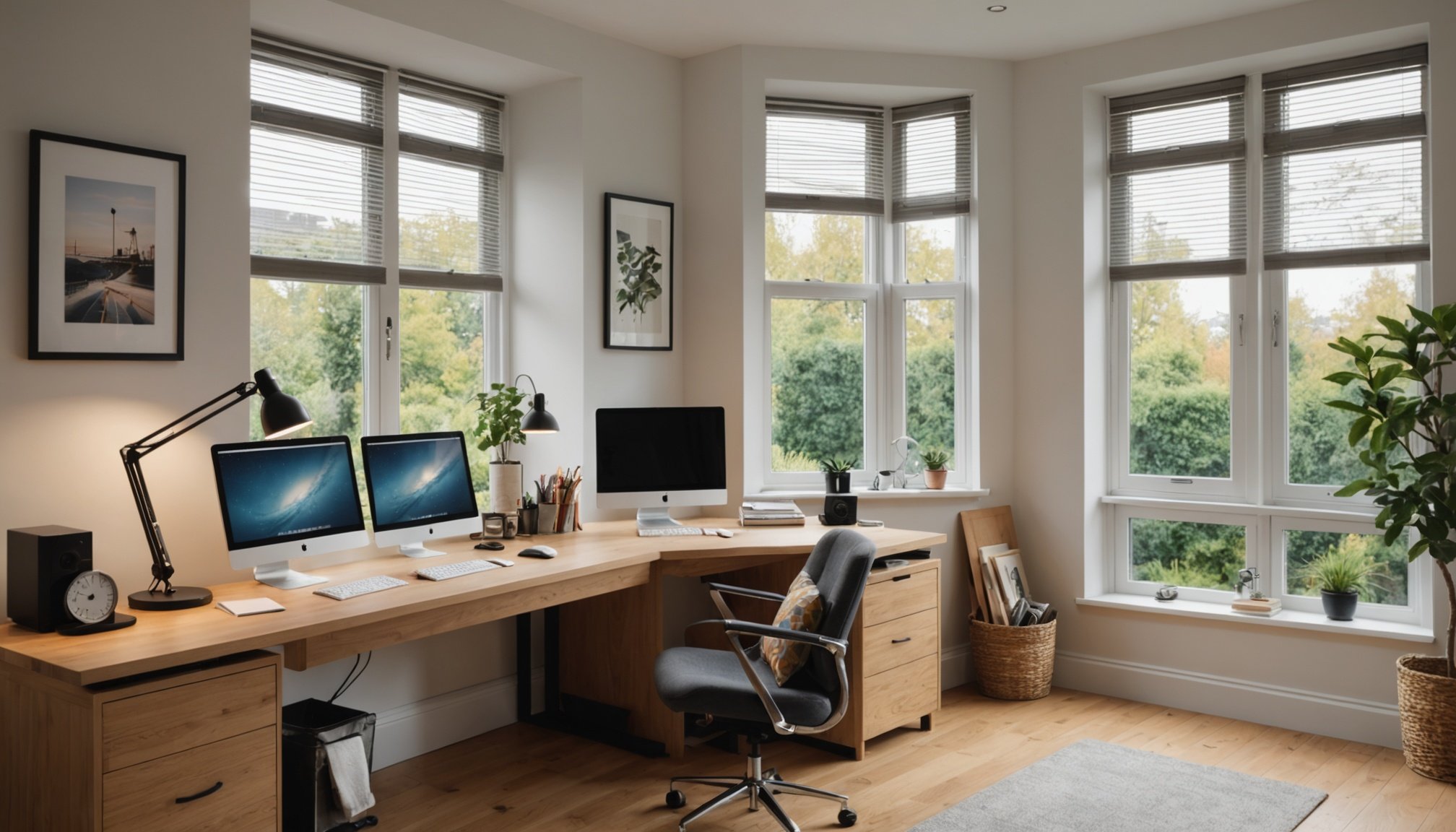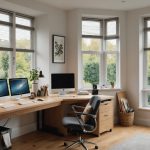Transform Your UK Home Office: Smart Tips to Minimize Eye Strain and Enhance Natural Light
In the modern era, where working from home has become the new norm, creating a home office that is both productive and comfortable is crucial. Two of the most critical aspects to focus on are minimizing eye strain and optimizing natural light. Here’s a comprehensive guide to help you transform your home office into a haven of productivity and well-being.
Understanding the Importance of Natural Light
Natural light is not just aesthetically pleasing; it has significant benefits for your health and productivity. Here are a few reasons why natural light should be a priority in your home office:
Cela peut vous intéresser : Maximizing Under-Stair Storage: Creative Solutions for Your UK Terraced Home
-
Enhances Mood and Productivity: Natural light can boost your mood and energy levels, making you more productive throughout the day. Studies have shown that workers exposed to natural light tend to have better overall well-being and higher productivity rates[2][4].
-
Reduces Eye Strain: Working in a well-lit room with natural light can reduce the strain on your eyes. This is because natural light helps to balance the contrast between your screen and the surrounding environment, making it easier on your eyes[2][4].
En parallèle : Selecting Eco-Friendly Timber for Your Outdoor Deck: A Guide for Sustainable Building in UK Rural Homes
Maximizing Natural Light in Your Home Office
To make the most of natural light, here are some practical tips:
Positioning Your Desk
Place your desk near a window to take advantage of daylight. However, avoid placing your monitor directly in front of the window to prevent glare. Instead, position it at an angle to the window to maximize the benefits of natural light without the drawbacks[2][4].
Window Treatments
Use sheer or translucent window treatments to allow sunlight to penetrate while minimizing glare on your screen. This can include blinds, curtains, or shades that filter the light without blocking it entirely[2].
Mirror Placement
Strategically place mirrors in your room to reflect natural light into darker areas. This can help distribute the light more evenly and make your space feel brighter and more welcoming[2].
Furniture Layout
Arrange your workspace to take advantage of the times of day when natural light is at its peak. For example, if the morning sun is strongest on one side of your room, adjust your furniture accordingly to make the most of this light[2].
Optimizing Office Lighting
While natural light is ideal, it’s not always available, especially during the evening or in rooms with limited window space. Here’s how you can optimize your office lighting to reduce eye strain and enhance your workspace:
Layered Lighting
Use a combination of different light sources to create layered lighting. This includes:
- Ambient Lighting: General lighting that illuminates the entire room.
- Task Lighting: Focused lighting for specific tasks, such as a desk lamp for your workspace.
- Accent Lighting: Lighting used to highlight certain areas or features of the room[2].
Color Temperature
Choose light bulbs with a color temperature that complements your work. For example:
- Cool White Light (5000K-6500K): Ideal for task-oriented work as it enhances focus and alertness.
- Warm White Light (2700K-3000K): Better for relaxation and reading as it creates a cozy atmosphere[4].
Desk Lamp
A good desk lamp can be a game-changer. Look for one that is adjustable and has a full-spectrum light bulb to mimic natural daylight. This can help reduce eye strain by providing focused lighting exactly where you need it[4].
Reducing Eye Strain
Eye strain is a common issue for those who spend long hours in front of screens. Here are some tips to help you reduce eye strain in your home office:
Follow the 20-20-20 Rule
Every 20 minutes, take a 20-second break and look at something 20 feet away. This helps distribute tears evenly across your eyes and reduces the risk of dry eyes and eye strain[3].
Adjust Your Screen Settings
Lower the brightness of your screen to match the lighting in your room. Also, adjust the color temperature of your screen to reduce blue light emission, especially in the evening. Blue light can cause eye strain and disrupt your sleep patterns[3].
Eye Massagers
Consider using an eye massager to relieve tension and reduce eye strain. These devices often combine heat, vibration, and massage to boost blood flow and stimulate lymphatic drainage around the eyes. For example, the Theragun Smart Goggles offer personalized vibration patterns and heat therapy to soothe tired eyes[5].
Ergonomic Workspace Design
An ergonomic workspace is essential for reducing eye strain and improving overall comfort. Here are some key elements to consider:
Chair and Desk
- Chair: Ensure your chair is adjustable in height and has lumbar support. Your feet should rest flat on the floor or on a footrest, and your knees should be at a 90-degree angle[1].
- Desk: Your desk should be at a height that allows your forearms to rest parallel to the floor. Keep items within easy reach to avoid overstretching[1].
Keyboard and Mouse
- Keyboard: Position your keyboard flat or slightly downward, with a small space between you and the keyboard to rest your hands when not typing.
- Mouse: Keep your mouse close to the keyboard to avoid overreaching and maintain a neutral wrist position[1].
Regular Breaks
Encourage regular breaks to reduce the risk of eye strain and muscle fatigue. Take a break every hour to move around or change your posture[1].
Practical Tips for Your Home Office
Here are some additional practical tips to enhance your home office:
Incorporate Plants
Adding plants to your home office can improve air quality and create a calming atmosphere conducive to productivity. Biophilic design, which emphasizes the connection between humans and nature, has been shown to reduce stress and improve cognitive function[4].
Personalize with Art and Color
Select artwork and color schemes that inspire and motivate you. Tailor the environment to your personal taste to make your workspace more enjoyable and productive[4].
Employer Responsibilities for Remote Workers
For those who work from home, employers still have a legal duty to ensure their workers’ health and safety. Here are some key responsibilities:
- Inform and Train Workers: Provide workers with necessary information and training on proper display screen equipment (DSE) and workstation usage[1].
- Conduct DSE Workstation Assessments: Conduct assessments for each employee to ensure their workspace is set up to reduce the risk of DSE-related ill health[1].
- Offer Guidance and Equipment: Offer guidance, training, and perhaps equipment to help remote workers set up their home workstations safely and ergonomically[1].
Table: Comparing Eye Massagers
Here is a comparison of some top-rated eye massagers to help you make an informed decision:
| Eye Massager | Key Features | Price | Best For |
|---|---|---|---|
| Theragun Smart Goggles | Personalized vibration patterns, heat therapy, biometric sensor | £189 | Advanced features and personalized experience |
| Bob & Brad Eye Oasis 2 | Soothing heat therapy, adjustable pressure modes, double-layer massage pad | £99 | Targeted relief and travel convenience |
| Homedics Massaging Eye Mask with Speakers | Gentle vibration massage, built-in headphones, adjustable massage settings | £9.99 | Budget-friendly and relaxation-focused |
Transforming your home office into a space that minimizes eye strain and maximizes natural light is a worthwhile investment in your health and productivity. By following these tips, you can create an environment that is both comfortable and conducive to your well-being.
As Dr. Jonathan Kentley, consultant dermatologist at Montrose London, notes, “Gentle heating and massage increases blood flow around the eyes and stimulates lymphatic drainage, which may help reduce swelling and limit the development of eye bags. It has also been reported that they may reduce eye strain by relaxing the muscles around the eye.”[5]
By optimizing your lighting, designing an ergonomic workspace, and incorporating practical tips, you can ensure that your home office is a place where you can work efficiently and comfortably. Remember, a well-designed workspace is not just about aesthetics; it’s about creating an environment that supports your health and productivity.











